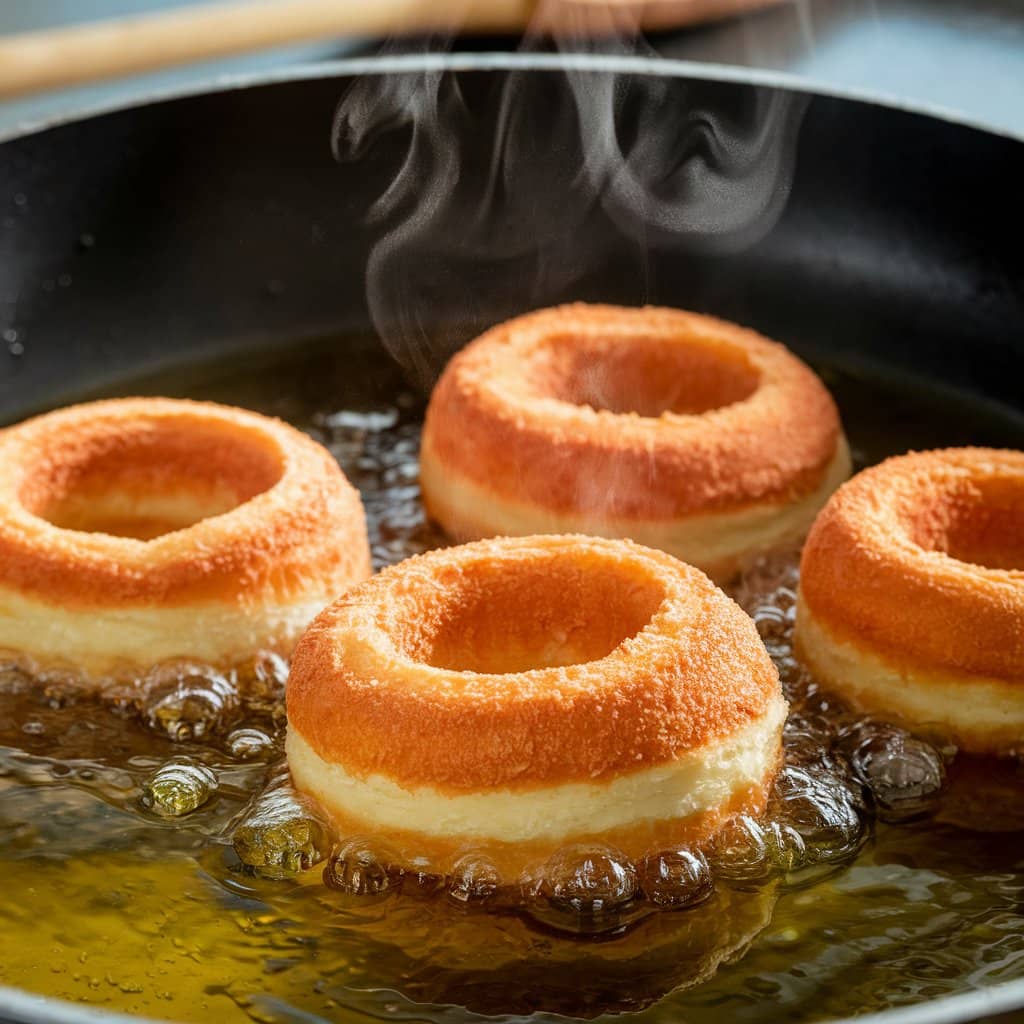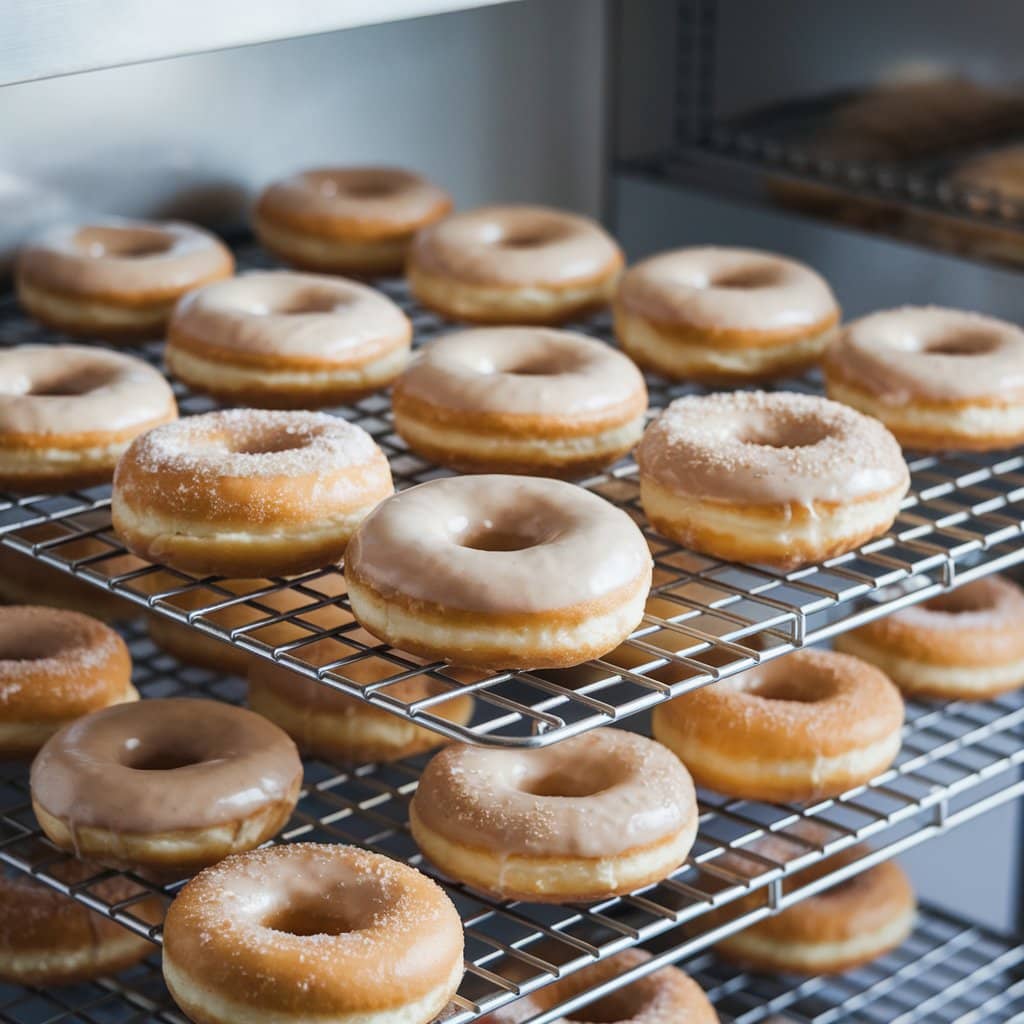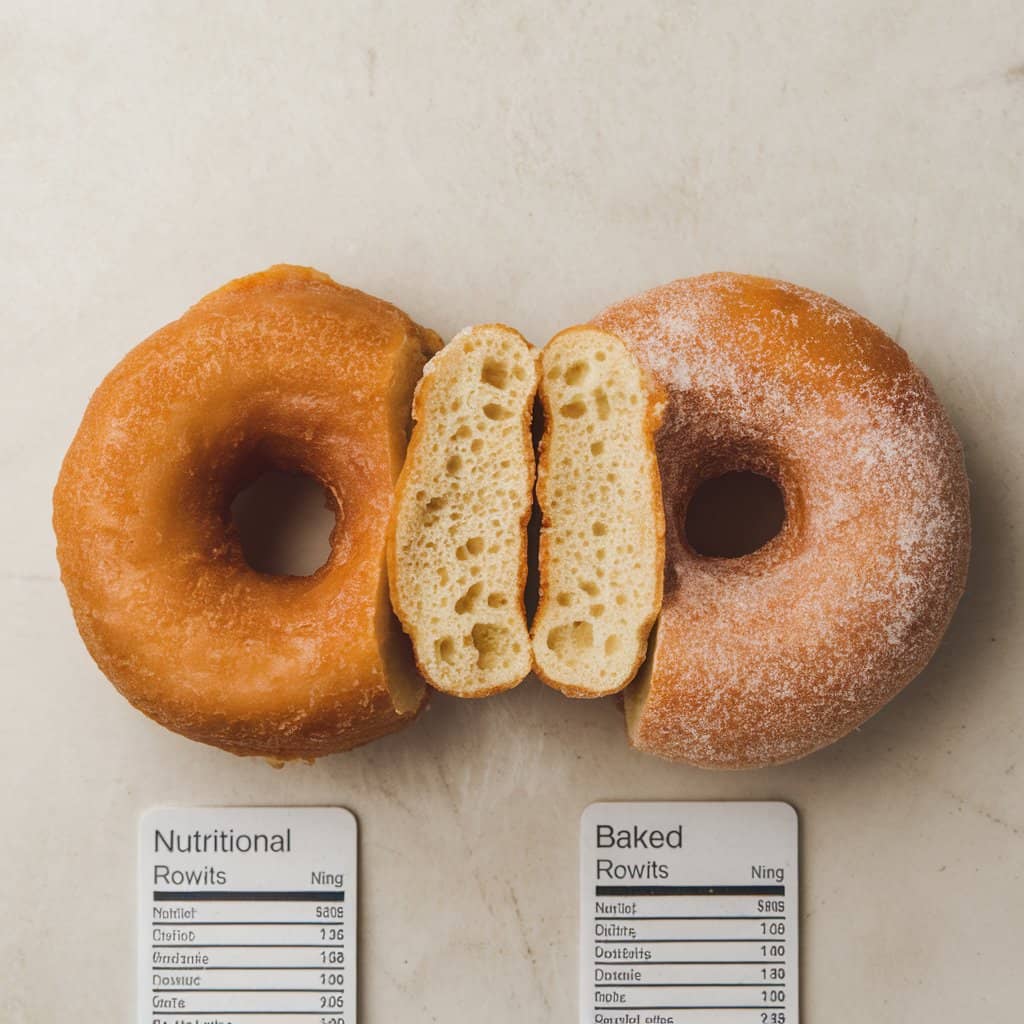Doughnuts have delighted people around the world for generations. Millions enjoy these treats in various forms, whether glazed, powdered, or filled. The method of preparation plays a crucial role in determining the taste, texture, and nutritional value of doughnuts. This factor leads many people to wonder: are doughnuts better fried or baked?
Fried doughnuts offer a crispy, golden exterior and a rich, fluffy interior. In contrast, baked doughnuts provide a lighter texture and a healthier profile due to their lower oil content. This article explains everything you need to know about fried and baked doughnuts. We will compare their taste, texture, preparation methods, and nutritional impact. By the end, you will have all the information needed to choose the perfect doughnut style for your cravings and dietary goals.
Table of contents
Fried Doughnuts Overview
What Are Fried Doughnuts?
Fried doughnuts are the traditional form of doughnuts, cooked by submerging dough in hot oil until golden brown. This method gives them their characteristic crispy outside and soft, airy inside. Popular types include classic yeast doughnuts, crullers, and jelly-filled varieties.

History of Fried Doughnuts
The history of fried doughnuts dates back centuries, with roots in various cultures. For example, early recipes originated from Dutch settlers in the Americas, who made “olykoeks” (oil cakes). Over time, these treats gradually evolved into the ring-shaped doughnuts we know today, thanks in part to advancements in cooking methods and culinary techniques.
How Fried Doughnuts Are Made
- Preparation: Dough is made using flour, sugar, eggs, and yeast or baking powder.
- Shaping: The dough is rolled, cut into desired shapes, and left to rise.
- Frying: Doughnuts are deep-fried in hot oil (typically 350-375°F) until they turn golden brown.
- Topping: After cooling slightly, doughnuts are glazed, sugared, or frosted.
Taste and Texture of Fried Doughnuts
Fried doughnuts are known for their crispy crust and soft, fluffy inside. Their fried exterior creates a satisfying crunch that contrasts with the light, airy dough. The frying process also gives them a rich, buttery flavor that’s hard to replicate with baking.
Popular Types of Fried Doughnuts
- Glazed Yeast Doughnuts: Light and airy with a sugary glaze.
- Old-Fashioned Doughnuts: Dense and crispy with a cracked exterior.
- Jelly-Filled Doughnuts: Soft doughnuts filled with sweet fruit preserves.
- Chocolate-Frosted Doughnuts: Topped with rich chocolate icing.
Baked Doughnuts Overview
What Are Baked Doughnuts?
Bakers prepare baked doughnuts using an oven instead of frying them in oil. They mix a batter similar to cake mix, pour it into specialized doughnut pans, and bake it until golden brown. Baked doughnuts have a denser, more cake-like texture compared to their fried counterparts.

History of Baked Doughnuts
The concept of baked doughnuts emerged as a healthier alternative to traditional fried versions. While they don’t have the deep-fried crunch, their ease of preparation and reduced fat content gained popularity in home baking and health-conscious circles.
How Baked Doughnuts Are Made
- Preparation: A batter is made with ingredients like flour, sugar, eggs, baking powder, and milk.
- Shaping: The batter is poured into non-stick doughnut pans designed with ring-shaped molds.
- Baking: Doughnuts are baked in the oven at 350-375°F for 10-15 minutes.
- Topping: After cooling, they can be glazed, iced, or sprinkled with powdered sugar.
Taste and Texture of Baked Doughnuts
Baked doughnuts feel lighter and less greasy than fried ones. Their texture resembles cake, providing a moist, tender bite with a slightly crispy edge when baked properly. Since they aren’t fried in oil, they deliver a cleaner, more subtle flavor.
Popular Types of Baked Doughnuts
- Cinnamon Sugar Doughnuts: Rolled in a mixture of cinnamon and sugar for a sweet-spicy kick.
- Vanilla Glazed Doughnuts: Covered in a smooth vanilla glaze for extra sweetness.
- Chocolate Baked Doughnuts: Made with cocoa powder and topped with chocolate icing.
- Pumpkin Spice Doughnuts: Spiced with cinnamon, nutmeg, and pumpkin puree, perfect for fall treats.
Health Comparison
When deciding between fried and baked doughnuts, health considerations play a significant role. Let’s compare them based on key nutritional factors such as calorie content, fat levels, sugar amounts, and potential health benefits.

Calorie Content
- Fried Doughnuts:
Fried doughnuts are generally higher in calories due to the oil absorbed during frying. A standard glazed fried doughnut can contain 250-400 calories, depending on its size and toppings. - Baked Doughnuts:
Baked doughnuts tend to have fewer calories, averaging between 150-250 calories per serving. Because they aren’t cooked in oil, baked doughnuts are a better option for calorie-conscious eaters.
Fat Content
- Fried Doughnuts:
The frying process significantly increases fat content. A single fried doughnut can have 10-20 grams of fat, potentially including unhealthy trans fats if made with the wrong type of oil. - Baked Doughnuts:
Baked doughnuts are much lower in fat, with about 2-5 grams per serving, depending on the recipe. Using healthier ingredients such as whole wheat flour or plant-based milk can further reduce fat content.
Sugar Levels
- Fried Doughnuts:
Fried doughnuts often have higher sugar content due to sugary glazes, frostings, and fillings. They can contain 20-30 grams of sugar or more per serving. - Baked Doughnuts:
Baked doughnuts remain sweet but typically have less sugar, especially when homemade recipes use sugar substitutes or reduced-sugar glazes.
Nutritional Benefits
- Fried Doughnuts:
Fried doughnuts provide limited nutritional value because they are indulgent treats high in calories, fat, and sugar. - Baked Doughnuts:
Bakers can make baked doughnuts healthier by using nutrient-rich ingredients such as whole grains, nuts, fruits, and reduced sugar. They also provide room for customization, making it easier to balance taste and nutrition.
While both types of doughnuts are delicious, baked doughnuts clearly have a nutritional edge. They offer a lower-calorie, lower-fat alternative while still satisfying sweet cravings. However, fried doughnuts deliver an unbeatable taste and texture for occasional indulgence.
Culinary Differences
The preparation of fried and baked doughnuts varies significantly in terms of technique, equipment, and time required. Understanding these differences can help you choose the best method based on your preferences, available tools, and time constraints.
Preparation Methods
- Fried Doughnuts:
- Mixing the Dough: Bakers typically use a yeast-based dough, which needs time to rise.
- Shaping: After the dough rises, bakers roll it out and cut it into shapes with a doughnut cutter.
- Frying: Bakers deep-fry the shaped doughnuts in oil until they turn golden brown, creating an evenly crispy exterior.
- Topping: Once cooled, bakers dip the doughnuts in glaze, powdered sugar, or chocolate for added sweetness.
- Baked Doughnuts:
- Mixing the Batter: Bakers prepare a cake-like batter using standard baking ingredients such as flour, sugar, eggs, and milk.
- Shaping: They pour the batter into specialized doughnut pans with ring molds to create the classic doughnut shape.
- Baking: Bakers bake the doughnuts in an oven set to 350-375°F for 10-15 minutes until golden brown.
- Topping: After cooling, they glaze the baked doughnuts or dust them with powdered sugar for extra sweetness.
Equipment Required
- For Fried Doughnuts:
- Deep fryer or heavy pot
- Cooking thermometer (to maintain oil temperature)
- Doughnut cutter
- Slotted spoon or frying basket
- For Baked Doughnuts:
- Doughnut baking pan
- Oven
- Mixing bowls and whisk
Baking vs. Frying Time
- Frying Time:
- Doughnuts take only 1-2 minutes per side to fry, making them faster but requiring constant monitoring.
- Baking Time:
- Baked doughnuts take 10-15 minutes in the oven, with less active supervision required, making this method more convenient for home bakers.
Conclusion:
Fried doughnuts require more specialized equipment and closer monitoring, but they deliver an authentic, indulgent experience. Baked doughnuts are simpler to make at home, requiring only basic baking tools. Your choice will depend on the available equipment, desired flavor, and time commitment.
Pros and Cons
Both fried and baked doughnuts have their advantages and disadvantages. Whether you prioritize taste, health, or convenience, understanding the pros and cons of each method can help you decide which type of doughnut suits your lifestyle best.
Advantages of Fried Doughnuts
- Superior Taste and Texture:
- Fried doughnuts are crispy on the outside and light, fluffy, and tender on the inside.
- The frying process creates a golden crust with rich, caramelized flavors.
- Classic Doughnut Experience:
- They offer the authentic doughnut experience associated with traditional recipes.
- Versatile Toppings and Fillings:
- Fried doughnuts are sturdy enough to hold heavy glazes, frosting, and fillings like custard or jelly.
Disadvantages of Fried Doughnuts
- Higher Caloric Content:
- Due to oil absorption, fried doughnuts are higher in calories, fat, and overall richness.
- More Equipment Needed:
- Frying requires deep fryers or heavy pots, oil thermometers, and a safe cooking setup.
- Messy and Time-Consuming:
- Frying tends to be messy and requires constant monitoring, which makes cleanup more challenging.
Advantages of Baked Doughnuts
- Healthier Alternative:
- Baked doughnuts have less fat, fewer calories, and minimal oil, making them a more health-conscious choice.
- Easier and Safer to Make:
- Baking doughnuts eliminates the need for hot oil or deep-frying, reducing the risk of burns and oil spills.
- Customizable Recipes:
- Home bakers can adjust ingredients, use whole grains, or reduce sugar for healthier versions.
- Less Cleanup:
- Baking is less messy, with fewer utensils and tools required.
Disadvantages of Baked Doughnuts
- Different Texture:
- Baked doughnuts are denser and cake-like, which might not satisfy those craving the airy, fried texture.
- Requires Special Pans:
- You need specific doughnut pans for shaping, which might not be available in every kitchen.
- Less Authentic Flavor:
- The classic deep-fried taste is hard to replicate with baking, leaving some purists disappointed.
Choosing between fried and baked doughnuts ultimately comes down to personal preferences. If you value indulgent taste and crispy texture, then fried doughnuts are the way to go. On the other hand, for a healthier, more convenient option, baked doughnuts provide a satisfying alternative. Overall, both methods have unique pros and cons, allowing you to enjoy doughnuts based on your taste and dietary goals.
Best Option for You
Choosing between fried and baked doughnuts depends on your personal preferences, dietary goals, and special occasions. Let’s explore how to make the best decision based on various factors.

Choosing Based on Preferences
- For Taste Lovers:
- If you prioritize flavor, fried doughnuts are unbeatable. Their crispy exterior and light, airy interior create a satisfying contrast.
- Baked doughnuts, while delicious, have a cake-like texture that appeals to those who enjoy denser, less oily treats.
- For Texture Enthusiasts:
- Prefer a crunch and fluff combo? Fried doughnuts excel in this category.
- For a softer, more uniform texture, baked doughnuts offer consistency in every bite.
Dietary Considerations
- Health-Conscious Eaters:
- Baked doughnuts contain less fat and fewer calories, making them a better choice for weight management and heart-healthy diets.
- Use healthier ingredients like whole-wheat flour, almond milk, and sugar substitutes in baked recipes for an even lighter treat.
- Gluten-Free and Vegan Options:
- Bakers can make both types of doughnuts gluten-free or vegan by using the right substitutes.
- However, baked doughnuts are easier to adapt because the batter is more forgiving.
- Allergies and Sensitivities:
- Baking allows more control over ingredients, reducing potential allergens like dairy, eggs, or specific oils found in fried doughnuts.
Special Occasions
- For Parties and Celebrations:
- Fried doughnuts are festive and indulgent, making them perfect for parties, celebrations, or dessert tables.
- Baked doughnuts work well for brunches, family gatherings, and health-focused events.
- Quick Treats or Gifts:
- Baked doughnuts are easier to prepare in bulk, making them suitable for holiday gift boxes or bake sales.
- Fried doughnuts are best when made fresh and served immediately for optimal taste.
The choice between fried and baked doughnuts ultimately depends on your preferences, health goals, and event needs. Fried doughnuts shine when indulgence and tradition are key, while baked doughnuts excel in convenience and nutritional value. Enjoying either type can be a satisfying experience when tailored to your taste and lifestyle.
FAQs About Fried and Baked Doughnuts
Here are answers to common questions about fried and baked doughnuts, designed to clarify popular concerns and preferences.
Are Baked Doughnuts Healthier Than Fried Doughnuts?
Yes, baked doughnuts are generally healthier than fried ones because they contain less fat and fewer calories. Baking eliminates the need for oil, reducing the overall calorie count while still delivering a tasty treat.
Do Baked Doughnuts Taste the Same as Fried Doughnuts?
Not exactly. Baked doughnuts have a cake-like texture and are less crispy than fried doughnuts. While they can be just as delicious with the right toppings, they lack the deep-fried flavor and crunch that traditional doughnuts have.
Can I Fry Doughnut Batter Meant for Baking?
No, baked doughnut batter is usually thinner and designed to rise in the oven. Frying it could cause the dough to disintegrate in the oil. Use yeast-based dough for frying instead.
What Oil Is Best for Frying Doughnuts?
Neutral oils with a high smoke point, such as vegetable oil, canola oil, or peanut oil, are the best choices for frying doughnuts. They ensure even frying and maintain the doughnut’s natural flavor without adding any overpowering taste.
Can I Make Doughnuts Without a Doughnut Pan?
Yes, you can make baked doughnuts without a doughnut pan by using a muffin tin and rolling small balls of foil to place in the center of each cup. This creates the doughnut hole effect during baking.
How Do You Store Fried and Baked Doughnuts?
- Fried Doughnuts: Enjoy fried doughnuts fresh for the best taste. Store them in an airtight container at room temperature for up to 2 days.
- Baked Doughnuts: Keep baked doughnuts in an airtight container for 3-4 days. Freeze them if you need longer storage.
Conclusion:
Both fried and baked doughnuts offer unique experiences, from crispy and indulgent to light and health-conscious. Choosing between them depends on your taste preferences, dietary goals, and occasion. Whether you’re enjoying a deep-fried classic or a freshly baked doughnut, every bite can be a delightful treat.

